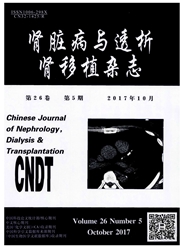

 中文摘要:
中文摘要:
目的:探讨细胞凋亡清除障碍及瓣状内切核酸酶1(Fenl)基因变异在狼疮性肾炎(LN)发病机制中的作用。方法:首先收集30例LN患者肾穿刺组织,用TUNEL法检测细胞凋亡,探讨LN病理分型、系统性红斑狼疮(SLE)活动度评分2000(SLEDAI2000)与肾脏组织细胞凋亡指数(AI)的关系;其次,收集50例LN患者,25例健康者,20例胃癌患者的外周血标本,采用全血基因组DNA柱式试剂盒提取DNA,筑巢PCR扩增Fenl基因61563142—61563342目的片段,扩增后对目的基因进行测序,并将测序结果与基因数据库中人Fenl基因进行比较,计算突变位点频率,比较LN患者、胃癌患者、健康者Fenl基因突变情况。结果:(1)所有患者肾组织凋亡检测均为阳性,凋亡细胞在肾小球及肾小管均呈散在分布,SLEDAI与其AI呈正相关(r=0.39,P〈0.05)。根据ISN/RPS2003制定的病理分型标准,30例LN患者中,病理类型以Ⅳ型最多(40.00%),其次为Ⅱ型(26.67%),Ⅲ型16.67%,V型13.33%,VI型3.33%,无I型病变患者。(2)三组Fenl基因61563142~61563342目的片段未发现有统计学意义的碱基变异。结论:LN患者存在细胞凋亡清除障碍,凋亡细胞的数量越多,SLE病情越活跃;LN患者Fenl基因61563142~61563342目的片段中未发现碱基变异,尚需要扩大样本量,或进行该基因的全基因组关联研究进一步证实Fenl基因在LN中的作用。
 英文摘要:
英文摘要:
Objective:To evaluate the role of cell apoptosis imbalance and Fenl gene mutation in the pathogenesis of lupus nephritis. Methodology: ( 1 ) Thirty paraffin organizations from renal biopsy of patients with LN was used TUNEL method to detect the cell apoptosis,the relation of LN pathology classification, SLE activity index 2000 (SLEDAI 2000) and kidney tissue cell apoptosis index (AI) was discussed. (2) Fenl gene 61563142 -61563342 were analyzed by extraction of genomic DNA from the peripheral blood of 50 LN patients ,25 healthy individuals and 20 patients with cancer of the stomach. Results : ( 1 ) The diffused apoptosis was identified in all samples of 30 LN patients ( LN-Ⅳ 40. 0%, LN-Ⅱ 26. 7%, LN-Ⅲ 16. 7% ,LN-Ⅴ0. 13% and LN type 0 01% ). The correlation analysis showed that SLEDAI was significantly correlated with apoptosis index ( r = 0. 39, P 〈 0. 05 ). (2) Fenl gene 61563142 - 61563342 was not significant difference among LN patients,healthy controls and patients with stomachcancer. Conclusion: Our data suggested that the cell apoptosis dysfunction play a key role in the pathogenesis of LN although Fenl gene 61563142 - 61563342 was not found significant difference in LN patients. The larger sample or Genome-Wide Association Studies should be needed.
 同期刊论文项目
同期刊论文项目
 同项目期刊论文
同项目期刊论文
 期刊信息
期刊信息
